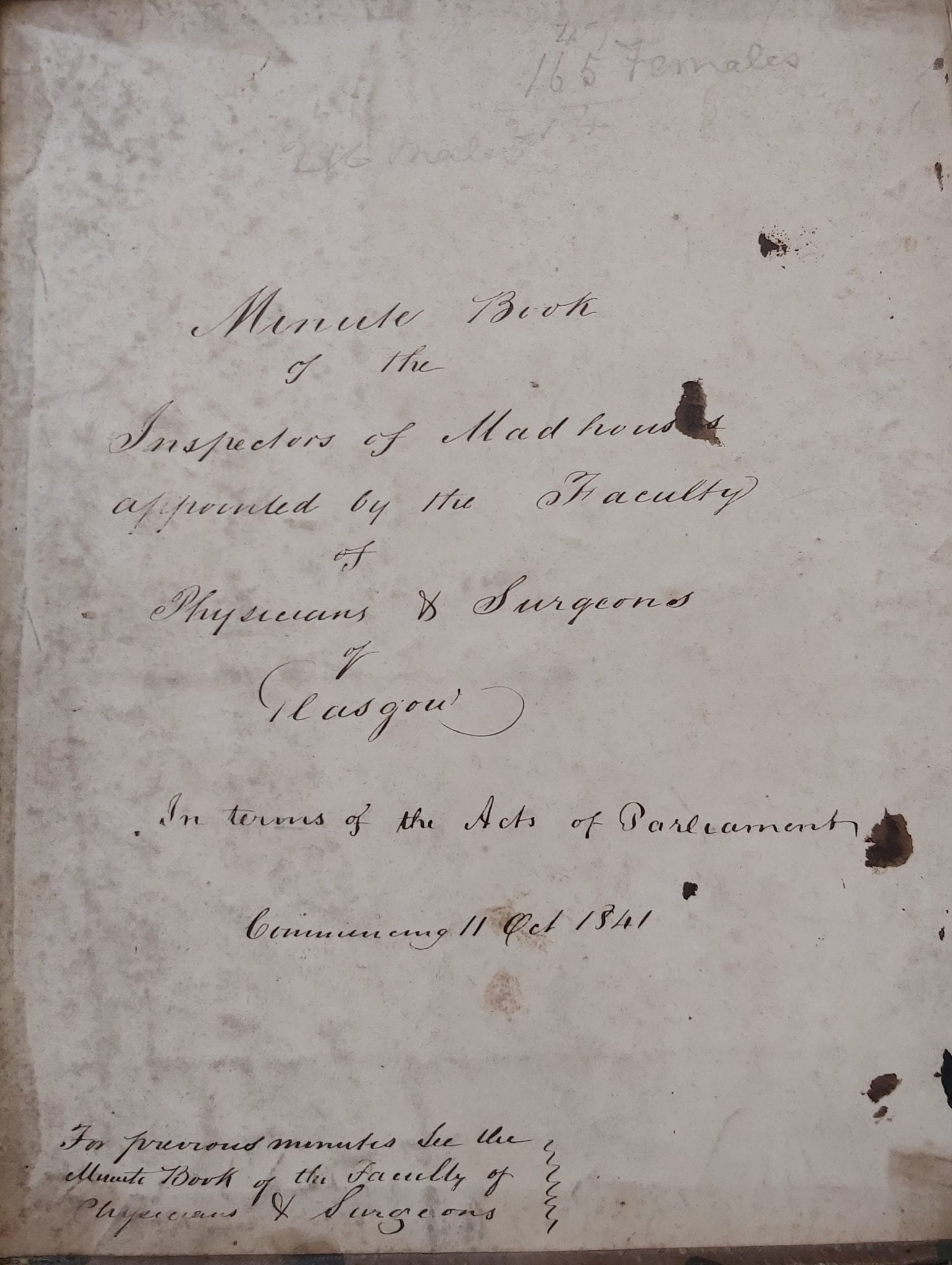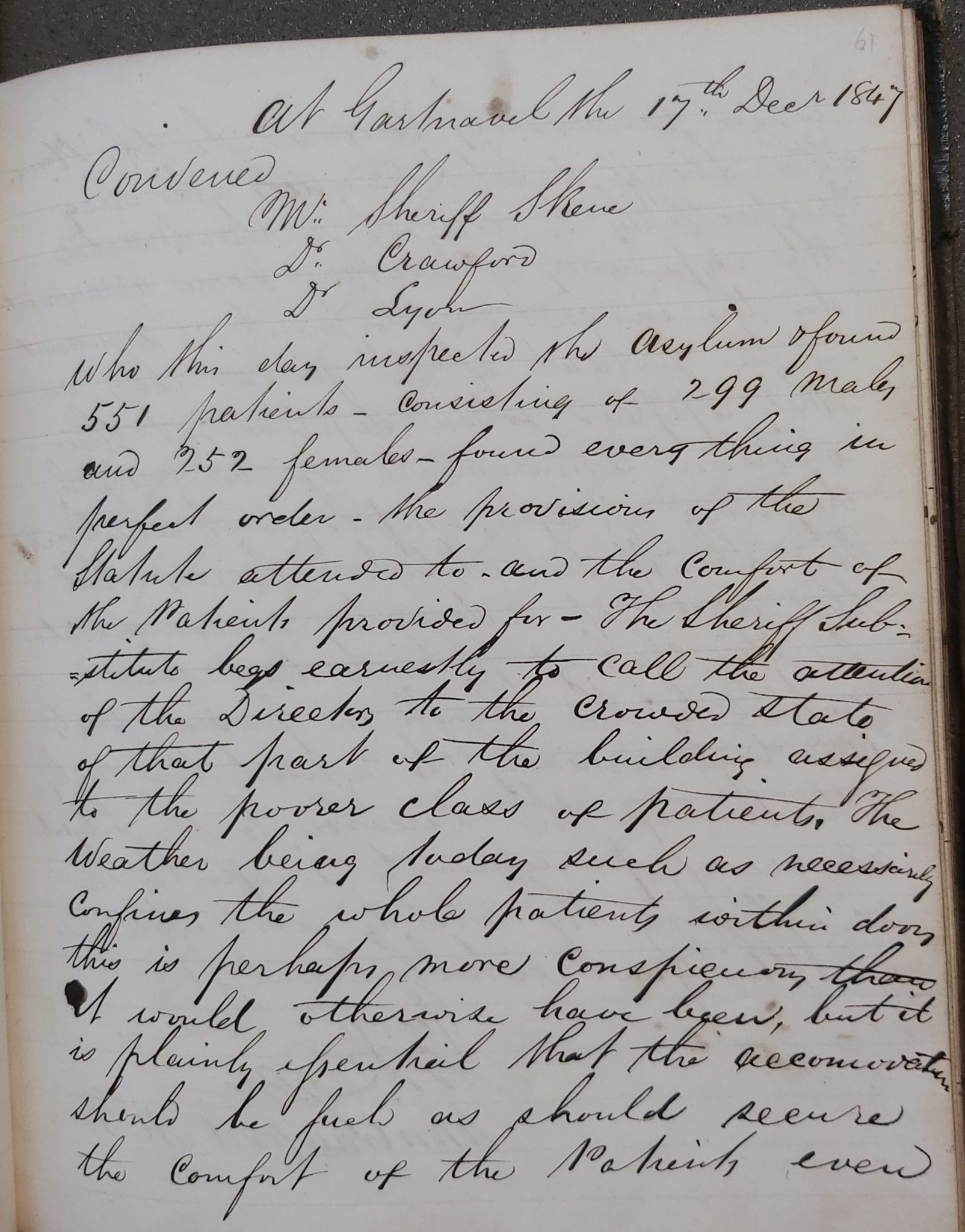Although the College’s exhibition, Great Minds: the brain in medicine, surgery and psychiatry, is currently closed due to the coronavirus crisis, we’re continuing to learn more about the collections in the exhibition and those connected to it.
When we do an exhibition we want to continue to reveal and share collections knowledge during the months it is open. Given our small exhibition space, we often have to leave key items out, even if they are an important part of the story. The Reports of the Inspectors of Madhouses, which are part of the College’s official records, are a great example of this.

The College appointed Inspectors of Madhouses from 1815, when the Act to Regulate Madhouses in Scotland was introduced. Along with the Royal College of Physicians of Edinburgh, the Faculty of Physicians and Surgeons of Glasgow (as the College was known then), appointed doctors to inspect asylums (both public and private) along with the Sheriff of the county, and to report on these inspections. From 1815 to 1841, these reports appeared in the College minute books.
The Minute Book below (which is unfortunately faded and difficult to read)from 26th September 1815 shows the memorandum of the meeting between the Sheriff and the Faculty, setting out their responsibilities. The entry also records the appointment of the first Inspectors of Madhouses in Glasgow – Mr William Anderson, Dr James Monteath, Mr William Couper and Dr Richard Millar.

In 1841, a separate minute book was created for the Inspectors to record their reports. The Reports of the Inspectors of Madhouses comprises two volumes, 1841-1857 (RCPSG 1/1/6/1) and 1857 (RCPSG 1/1/6/2). The reports ended in 1857 with the introduction of the Lunacy (Scotland) Act, which further improved the effectiveness of reporting on the conditions in asylums.

So why are these reports of interest, and what do they contain? Firstly, they provide an intriguing glimpse into asylums during this early period in the development of psychiatry and the treatment of mental illness, not only in the larger public institutions, but also in the smaller, private asylums dotted around the county. They are also of interest because they highlight the role of the College and its members in the early attempts to improve conditions in asylums.
Many of the reports from the 1841-1857 books record general conditions, including cleanliness and ventilation. They always record the number of patients, both male and female, and that all patients have been seen during the visit. The Inspectors were also looking at how patients were treated, for example whether any patients were under restraint, or in seclusion. For example, the short report below from the inspection of Springbank Retreat (a small, private asylum for women) in 1841, records that there were “five female patients in the house and none of them under restraint.”

The reports often highlight areas for improvement. For example, it is common to see requests for admission books or case books to be kept, recording each patient with notes, and any dismissals. There are also recommendations for patients with epilepsy, for example lower beds. In one report from 24th April, 1857, after a visit to Barnhill Asylum, the Inspectors go into great detail about the issues with the asylum’s wardens, finding them “by no means satisfactory.” The report states: “The head warden does not appear a man of sufficient intelligence or experience for the situation.”
While the regime of inspections aimed to improve conditions in the asylums of Glasgow and Lanarkshire, it is clear from some of the reports that they had a long way to go. A report on an inspection at Gartnaval Royal Asylum, from 17th December 1847, counts the number of patients as 551. The report “begs earnestly to call the attention of the Directors to the crowded state of that part of the building assigned to the poorer class of patients.” The report later states that this lack of adequate accommodation has been noted on previous visits.

The reports provide a valuable picture of the range of asylums in operation in the area at this time. In addition to the main Glasgow asylum at Gartnaval, the inspectors also visited the ‘Lunatic department’ of the Town’s Hospital. Other public asylums were Barnhill (which was replaced by the Barony Parochial Asylum in the 1880s), and Govan Asylum. The private asylums visited include Garngadhill (the first private asylum in the region, set up by licentiate and fellow of the College William Drury in 1823), Springbank Retreat, Dalbeth asylum, Blackfaulds asylum, and Longdales House, Bothwell.
We’ll continue to try to learn more about our collections and to share that learning as much as we can, while our exhibitions are closed and our collections are locked away. Hopefully this will encourage further research interest and future enquiry. If so, please do get in touch with us via library@rcpsg.ac.uk or @RCPSGHeritage on Twitter.


Leave a Reply